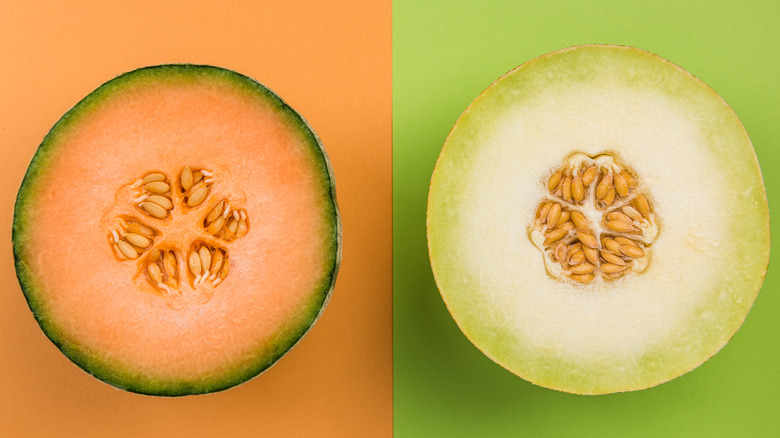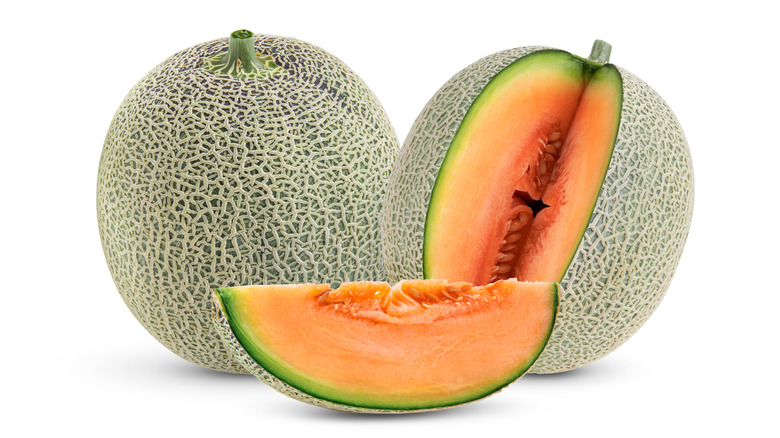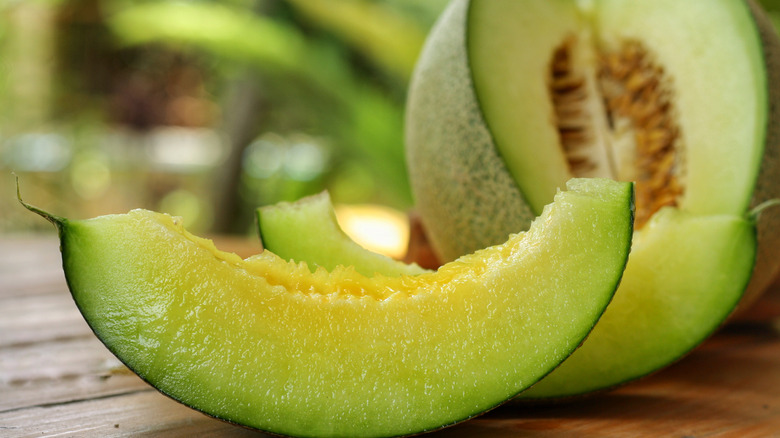What Makes Honeydew Different From Cantaloupe?
Stop by your local farmer's market and get to lifting. You can't go wrong with a fresh melon. It's the perfect light breakfast, side to hamburgers, or even dessert for those times you need a little something sweet.
Of the melons at the market — or your local grocery store — honeydew and cantaloupe are some of the most popular. Mayo Clinic says honeydew and cantaloupe are within the muskmelon family and originally grew in the Middle East. Per the University of Arkansas Division of Agriculture, both fruits belong to the Cucumis melo species.
As for tangible similarities, take a bite. Both fruits bring sweet, versatile flavors sure to spruce up your next salad or snack. Often interchangeable, these two melons make for seamless recipe substitutions that practically scream summer. And they're equally important to rinse prior to digging in.
When you cut into them, however, you'll detect the most significant differences. Beyond slight deviations in external appearances, the two fruits set themselves apart via variances in color and taste.
Cantaloupe has a distinct texture and vitamin content
When you're craving something refreshing, nothing beats a flavorful cantaloupe — except for maybe some added prosciutto.
According to Healthline, both honeydew and cantaloupe consist of nearly identical water and calorie counts, as well as similar ratios of fat, protein, carbs, and fiber. The high water content of roughly 90% makes both fruits sneaky forms of hydration. They're also similarly packed with minerals and vitamins, albeit different quantities of Vitamin A and Vitamin C; cantaloupe contains significantly more of both.
So to know which melon you're actually buying, it's what's on the outside that counts.
While broadly close in external appearance (both cantaloupe and honeydew come roughly the same size and shape), the former's skin is darker and more textured. Cantaloupe feels gritty and netted, distinct by the touch, as well as the tongue. While a sweet fruit, cantaloupe is also slightly less sweet than honeydew, per Spoon University — a relative difference most noticeable when tasting the fruits side-by-side.
Honeydew's green interior comes with increased sweetness
When it comes to honeydew, it's easy being green. On the outside, cantaloupe's sister fruit may look like just another melon, but honeydew tastes sweeter — and maintains a firmer texture than cantaloupe.
The level of sweetness predominantly characterizes the two fruits' flavors, but honeydew and cantaloupe are perhaps most noted for their deviances in color. Cantaloupe is a light orange, while a muted green tends to characterize cut-open honeydew.
Yet while honeydew's trademark, this muted green is not consistent across the melon. The fruit can come either green or orange, confusing the gap between honeydew and cantaloupe's color distinction. As for the flavors of this green-or-orange melon, Whole Foods indeed likens orange honeydew to cantaloupe. Green honeydew comes with a hard shell, light fragrance, and sweet taste in traditional honeydew form, whereas the orange iteration — while externally identical to its green counterpart — matches cantaloupe on the inside in color, flavor, and smell.
So if you'd rather not choose between honeydew and cantaloupe, it's easy to opt for a watermelon instead. With any melon in tow, you've guaranteed your next barbecue will be a little sweeter.


